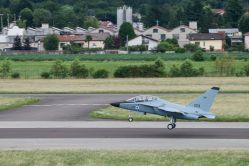Banned Weapons Used In Israel-Palestine Conflict?

As the conflict between the Israeli Defense Forces (IDF) and Palestinian groups intensifies, the unevenly matched sides continue to assault each other with a wide array of weapons including Israel’s use of internationally banned weapons, such as DIME (Dense Inert Metal Explosive), according to various media reports.
A statement issued by Al-Haq, a Palestinian human rights group, details how Hellfire rockets connected to drones are firing DIMEs.
A DIME bomb usually contains a mixture of explosive material, cobalt, nickel, iron and tungsten alloy and leaves almost no metallic fragments in the human body.
The injuries of victims who have been hit by DIME bombs are distinguishable from injuries from traditional, metal-coated weapons. Physicians in the Gaza Strip have observed how entire bodies have been cut in half, bones shattered, and skin, muscle and bones turned into charcoal due to the heavy burns caused by these bombs, according to the Electronic Intifada.
According to Al-Haq, Israel’s use of DIME bombs is in violation to international humanitarian law.
In addition, the 1980 convention on chemical weapons prohibits the use of weapons which “cause superfluous injury or excessive suffering.” Israel has signed that convention. The convention also prohibits the use of any weapon which aims to injure by placing fragments in the human body that escape detection.
Israel is reportedly using flechette shells, which spray out thousands of tiny and potentially lethal metal darts, against Palestinian civilians, according to the Guardian.
The IDF did not deny using the shells in the conflict. "As a rule, the IDF only employs weapons that have been determined lawful under international law, and in a manner which fully conforms with the laws of armed conflict," an IDF spokesperson was quoted as saying earlier in June.
The IDF justifies its pounding of civilian targets including hospitals, schools and UN shelters by claiming that Hamas fighters are using civilians as human shields.
Among the IDFs air and land assault on Gaza includes the use of 1000 lb (420 kg) bombs in civilian neighborhoods which are shot from drones and helicopter gunships. A 1000 lb bomb will leave crater about 20-30 feet (depending totally on ground type and fusing) with a blast shrapnel range of 600 feet.
In an article published by the Guardian, a former Israeli Air Force officer Yuli Novak, recalls the time the IAF dropped a one-tonne bomb on the home of Salah Shehadeh, the head of the military wing of Hamas, in Gaza.
“A 1,050 pounds of iron case and 950 pounds of RDX. 950 effing pounds of RDX. Let's put it this way. Remember when Tim McVeigh killed all those women and children in Oklahoma City? Remember how the front of the building was ripped off? A one ton bomb as she says or more precisely the modern equivalent of a Mark 84, or whatever they call it these days, would have completely leveled the federal building, reduced it to rubble, and severely damaged in not collapsed the adjacent buildings,” she explains.
A 1000 lb bomb “is designed to shatter concrete columns (2 foot steel reinforced) within 400 feet of the detonation point. If you'd ever seen one go off you would have a much better appreciation for what the words mean. It destroys with the shock wave,” Novak adds. Israel is reported to have dropped several one-tonne bombs on Gaza targets during the current conflict.
The Iron Dome system has also certainly helped the IDF protect its civilian population. However even the advanced missile defense system cannot intercept every missile.
According to the IDF, 255 rockets have hit Israel since the start of the operation. Only 71 were intercepted by the Iron Dome.
Nearly 300 rockets and mortars had been fired at Israel in recent weeks, including a barrage of about 80 projectiles on Monday (28 July) alone, the army said in a statement. Israel has responded with dozens of air strikes and eight Palestinian militants were killed on Monday.
Meanwhile Hamas and other Palestinian groups have spent the last few years building up an arsenal of basic rockets albeit nothing as sophisticated as the Israelis. According to the BBC, most are based upon Soviet-era technology and are artillery rockets that were designed to be fired in large barrages rather than individually.
Shorter-range systems include heavy mortars, Grad and Qassam rockets with ranges of up to 48km (30 miles) and 17km respectively. They threaten towns and cities in southern Israel, like Sderot, Ashkelon and even Beersheba and the port of Ashdod.
There is also the longer range Fajr-5, sometimes also designated the M75. It can reach up to 75km, threatening major population centres like Tel Aviv and Jerusalem, the report added. A novelty in this latest conflict is the apparent use by the Palestinians of an even longer-range system - thought to be a Syrian built-missile - the Khaibar-1.
Meanwhile, the Pentagon has approved giving the IDF rocket launchers, grenades, and other weapons that the U.S. keeps stockpiled in Israel as part of the $1 billion War Reserves Stock Allies-Israel program.











